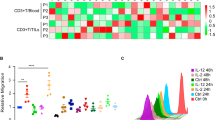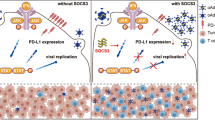Abstract
Ras mutations and overexpression of the Ras protein, p21Ras, are main causes of cancer development and progression, which has made the Ras gene and p21Ras important targets for therapy of Ras-driven cancers. We previously prepared recombinant adenovirus KGHV100 based on replication-defective adenovirus type 5, which could intracellularly express anti-p21Ras single chain fragment viable antibodies (scFv) and repress tumor growth in vitro and in vivo. However, the anti-tumor effects of this anti-p21Ras scFv were limited by short-term scFv expression due to a replication defect of KGHV100. To enhance the anti-tumor efficacy and safety of anti-p21Ras scFv, the present study constructed a dual-promoter-regulated recombinant adenovirus KGHV300 that carried anti-p21Ras scFv. In KGHV300, the expression levels of the essential replication genes E1a and E1b, were controlled by the human telomerase reverse transcriptase promoter and the hypoxia response element, respectively, and the anti-p21Ras scFv gene was controlled by the cytomegalovirus promoter. The conditional replication of KGHV300 and its antitumor efficacy were characterized in several tumor cell lines in vitro and in xenograft models of human breast cancer in nude mice. TCID50 assay demonstrated that KGHV300 could replicate in tumor cell lines but not in normal cell lines. 3-(4,5-dimethyl-2-thiazolyl)-2,5-diphenyl-2-H-tetrazolium bromide (MTT) assay indicated that the growth of tumor cells was effectively inhibited by KGHV300 infection. In MDA-MB-231 tumor xenograft models, KGHV300 effectively and significantly inhibited tumor growth and induced apoptosis of tumor cells. We concluded that the recombinant adenovirus KGHV300 may be a more potent and safer antitumor therapeutic for Ras-driven cancer biotherapy.
This is a preview of subscription content, access via your institution
Access options
Subscribe to this journal
Receive 12 print issues and online access
$259.00 per year
only $21.58 per issue
Buy this article
- Purchase on Springer Link
- Instant access to full article PDF
Prices may be subject to local taxes which are calculated during checkout






Similar content being viewed by others
References
Fernandez-Medarde A, Santos E . Ras in cancer and developmental diseases. Genes Cancer 2011; 2: 344–358.
Adjei AA . Blocking oncogenic Ras signaling for cancer therapy. J Natl Cancer Inst 2001; 93: 1062–1074.
Miyakis S, Sourvinos G, Spandidos DA . Differential expression and mutation of the ras family genes in human breast cancer. Biochem Biophys Res Commun 1998; 251: 609–612.
Liu X, Jakubowski M, Hunt JL . KRAS gene mutation in colorectal cancer is correlated with increased proliferation and spontaneous apoptosis. Am J Clin Pathol 2011; 135: 245–252.
Mills NE, Fishman CL, Rom WN, Dubin N, Jacobson DR . Increased prevalence of K-ras oncogene mutations in lung adenocarcinoma. Cancer Res 1995; 55: 1444–1447.
Saki M, Toulany M, Rodemann HP . Acquired resistance to cetuximab is associated with the overexpression of Ras family members and the loss of radiosensitization in head and neck cancer cells. Radiother Oncol 2013; 108: 473–478.
Hamdy S, Aprikian A, Begin L, Fair W, Bazinet M . Ras p21 overexpression is a late event in prostate-cancer. Int J Oncol 1994; 4: 627–631.
Gallick GE, Kurzrock R, Kloetzer WS, Arlinghaus RB, Gutterman JU . Expression of p21ras in fresh primary and metastatic human colorectal tumors. Proc Natl Acad Sci USA 1985; 82: 1795–1799.
Novara R, Coda R, Martone T, Vineis P . Exposure to aromatic amines and ras and c-erbB-2 overexpression in bladder cancer. J Occup Environ Med 1996; 38: 390–393.
Zheng ZY, Tian L, Bu W, Fan C, Gao X, Wang H et al. Wild-type N-Ras, overexpressed in basal-like breast cancer, promotes tumor formation by inducing IL-8 secretion via JAK2 activation. Cell Rep 2015; 12: 511–524.
Yang JL, Liu DX, Zhen SJ, Zhou YG, Zhang DJ, Yang LY et al. A novel anti-p21Ras scFv antibody reacting specifically with human tumour cell lines and primary tumour tissues. BMC Cancer 2016; 16: 131.
Yang JL, Pan XY, Zhao WX, Hu QC, Ding F, Feng Q et al. The antitumor efficacy of a novel adenovirus-mediated anti-p21Ras single chain fragment variable antibody on human cancers in vitro and in vivo. Int J Oncol 2016; 48: 1218–1228.
Shay JW, Wright WE . Telomeres and telomerase: implications for cancer and aging. Radiat Res 2001; 155: 188–193.
Hsu YH, Lin JJ . Telomere and telomerase as targets for anti-cancer and regeneration therapies. Acta Pharmacol Sin 2005; 26: 513–518.
Wu KJ, Grandori C, Amacker M, Simon-Vermot N, Polack A, Lingner J et al. Direct activation of TERT transcription by c-MYC. Nat Genet 1999; 21: 220–224.
Hewitson KS, Schofield CJ . The HIF pathway as a therapeutic target. Drug Discov Today 2004; 9: 704–711.
Semenza GL . Targeting HIF-1 for cancer therapy. Nat Rev Cancer 2003; 3: 721–732.
Welsh SJ, Powis G . Hypoxia inducible factor as a cancer drug target. Curr Cancer Drug Targets 2003; 3: 391–405.
Sokkar P, Sathis V, Ramachandran M . Computational modeling on the recognition of the HRE motif by HIF-1: molecular docking and molecular dynamics studies. J Mol Model 2012; 18: 1691–1700.
Lee KJ, Lee KY, Lee YM . Downregulation of a tumor suppressor RECK by hypoxia through recruitment of HDAC1 and HIF-1alpha to reverse HRE site in the promoter. Biochim Biophys Acta 2010; 1803: 608–616.
Su CQ, Sham J, Xue HB, Wang XH, Chua D, Cui ZF et al. Potent antitumoral efficacy of a novel replicative adenovirus CNHK300 targeting telomerase-positive cancer cells. J Cancer Res Clin Oncol 2004; 130: 591–603.
Post DE, Khuri FR, Simons JW, Van Meir EG . Replicative oncolytic adenoviruses in multimodal cancer regimens. Hum Gene Ther 2003; 14: 933–946.
Li Y, Idamakanti N, Arroyo T, Thorne S, Reid T, Nichols S et al. Dual promoter-controlled oncolytic adenovirus CG5757 has strong tumor selectivity and significant antitumor efficacy in preclinical models. Clin Cancer Res 2005; 11: 8845–8855.
Wirth T, Kuhnel F, Kubicka S . Telomerase-dependent gene therapy. Curr Mol Med 2005; 5: 243–251.
Cho WK, Seong YR, Lee YH, Kim MJ, Hwang KS, Yoo J et al. Oncolytic effects of adenovirus mutant capable of replicating in hypoxic and normoxic regions of solid tumor. Mol Ther 2004; 10: 938–949.
Post DE, Devi NS, Li Z, Brat DJ, Kaur B, Nicholson A et al. Cancer therapy with a replicating oncolytic adenovirus targeting the hypoxic microenvironment of tumors. Clin Cancer Res 2004; 10: 8603–8612.
Wang X, Su C, Cao H, Li K, Chen J, Jiang L et al. A novel triple-regulated oncolytic adenovirus carrying p53 gene exerts potent antitumor efficacy on common human solid cancers. Mol Cancer Ther 2008; 7: 1598–1603.
Wang YH, Liu S, Zhang G, Zhou CQ, Zhu HX, Zhou XB et al. Knockdown of c-Myc expression by RNAi inhibits MCF-7 breast tumor cells growth in vitro and in vivo. Breast Cancer Res 2005; 7: R220–R228.
Chen Q, Cui XX, Liang PF, Dou JX, Liu ZY, Sun WW . Immunotherapy with dendritic cells and cytokine-induced killer cells for MDA-MB-231 breast cancer stem cells in nude mice. Am J Transl Res 2016; 8: 2947–2955.
Li W, Miao X, Qi Z, Zeng W, Liang J, Liang Z . Hepatitis B virus X protein upregulates HSP90alpha expression via activation of c-Myc in human hepatocarcinoma cell line, HepG2. Virol J 2010; 7: 45.
Arango D, Mariadason JM, Wilson AJ, Yang W, Corner GA, Nicholas C et al. c-Myc overexpression sensitises colon cancer cells to camptothecin-induced apoptosis. Br J Cancer 2003; 89: 1757–1765.
Kieback DG . Adenovirus-mediated thymidine kinase gene therapy and coxsackie adenovirus receptor expression in ovarian cancer cells. Cancer Genom Proteom 2008; 5: 311–318.
Yun J, Rago C, Cheong I, Pagliarini R, Angenendt P, Rajagopalan H et al. Glucose deprivation contributes to the development of KRAS pathway mutations in tumor cells. Science 2009; 325: 1555–1559.
Kozma SC, Bogaard ME, Buser K, Saurer SM, Bos JL, Groner B et al. The human c-Kirsten ras gene is activated by a novel mutation in codon 13 in the breast carcinoma cell line MDA-MB231. Nucleic Acids Res 1987; 15: 5963–5971.
Shweta, Mishra KP, Chanda S, Singh SB, Ganju L . A comparative immunological analysis of CoCl2 treated cells with in vitro hypoxic exposure. Biometals 2015; 28: 175–185.
Shirato K, Kizaki T, Sakurai T, Ogasawara JE, Ishibashi Y, Iijima T et al. Hypoxia-inducible factor-1alpha suppresses the expression of macrophage scavenger receptor 1. Pflugers Arch 2009; 459: 93–103.
Yamanaka-Tatematsu M, Nakashima A, Fujita N, Shima T, Yoshimori T, Saito S . Autophagy induced by HIF1alpha overexpression supports trophoblast invasion by supplying cellular energy. PLoS One 2013; 8: e76605.
Dong X, Qu W, Ma S, Zhu Z, Zheng C, He A et al. Potent antitumoral effects of targeted promoter-driven oncolytic adenovirus armed with Dm-dNK for breast cancer in vitro and in vivo. Cancer Lett 2013; 328: 95–103.
Brennan AJ, House IG, Oliaro J, Ramsbottom KM, Hagn M, Yagita H et al. A method for detecting intracellular perforin in mouse lymphocytes. J Immunol 2014; 193: 5744–5750.
Gao H, Liu L, Qu ZY, Wei FX, Wang SQ, Chen G et al. Anti-adenovirus activities of shikonin, a component of Chinese herbal medicine in vitro. Biol Pharm Bull 2011; 34: 197–202.
Wang HG, Miyashita T, Takayama S, Sato T, Torigoe T, Krajewski S et al. Apoptosis regulation by interaction of Bcl-2 protein and Raf-1 kinase. Oncogene 1994; 9: 2751–2756.
Zhu W, Wei L, Zhang H, Chen J, Qin X . Oncolytic adenovirus armed with IL-24 inhibits the growth of breast cancer in vitro and in vivo. J Exp Clin Cancer Res 2012; 31: 51.
Guo J, Gao J, Li Z, Gong Y, Man X, Jin J et al. Adenovirus vector-mediated Gli1 siRNA induces growth inhibition and apoptosis in human pancreatic cancer with Smo-dependent or Smo-independent Hh pathway activation in vitro and in vivo. Cancer Lett 2013; 339: 185–194.
Uchida H, Tanaka T, Sasaki K, Kato K, Dehari H, Ito Y et al. Adenovirus-mediated transfer of siRNA against survivin induced apoptosis and attenuated tumor cell growth in vitro and in vivo. Mol Ther 2004; 10: 162–171.
Zhang Q, Chen G, Peng L, Wang X, Yang Y, Liu C et al. Increased safety with preserved antitumoral efficacy on hepatocellular carcinoma with dual-regulated oncolytic adenovirus. Clin Cancer Res 2006; 12: 6523–6531.
Acknowledgements
This work was supported by grants from the National Natural Science Foundation of China (No. 81460464) and the Applied Foundation Key Project of Yunnan Province (2013FA059).
Ethical statement
This study received the approval of the Ethics Board of Kunming General Hospital and is also in accordance with the Helsinki Declaration of 1975. Animals involved in the study were cared for in accordance with institutional guidelines.
Author information
Authors and Affiliations
Corresponding authors
Ethics declarations
Competing interests
The authors declare no conflict of interest.
Rights and permissions
About this article
Cite this article
Pan, X., Liu, X., Li, J. et al. The antitumor efficacy of anti-p21Ras scFv mediated by the dual-promoter-regulated recombinant adenovirus KGHV300. Gene Ther 24, 40–48 (2017). https://doi.org/10.1038/gt.2016.74
Received:
Revised:
Accepted:
Published:
Issue Date:
DOI: https://doi.org/10.1038/gt.2016.74
This article is cited by
-
RGD-p21Ras-scFv expressed prokaryotically on a pilot scale inhibits ras-driven colorectal cancer growth by blocking p21Ras-GTP
BMC Cancer (2024)
-
CIK cell-based delivery of recombinant adenovirus KGHV500 carrying the anti-p21Ras scFv gene enhances the anti-tumor effect and safety in lung cancer
Journal of Cancer Research and Clinical Oncology (2019)



